
 |


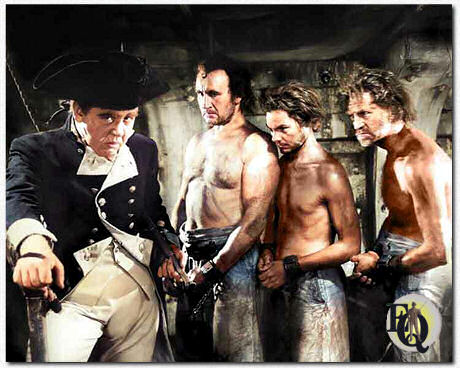 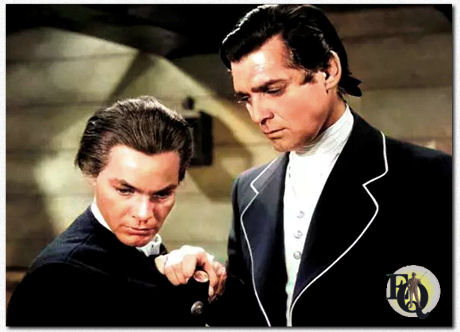 Above: two stills from Mutiny on the Bounty (MGM, Nov 8. 1935) Charles Laughton, Donald Crisp & Eddie Quillan (left) and Eddie Quillan and Clark Gable (right). |
|
The role for which Eddie is probably best known is Tommy Elison, the most
endearing and tragic character of the ill-fated crew, in the movie,
Mutiny on the Bounty (MGM, Nov 8. 1935). The film starred
Clark Gable, Charles Laughton, and Franchot Tone
(above). “There have been a lot of idols,” said Eddie, “but to me, Clark Gable was the greatest. Not only did the women like him, but the men liked him also. He had a great following with men. He was down-to-earth and was all man. Working with him was a lot of fun. I liked him tremendously.” His most treasured trophy came when he received the Box Office Blue Ribbon Award and the Screen Actors Guild Award (1936). It was the first time that SAG had given the award to an actor in a supporting role. (5) |
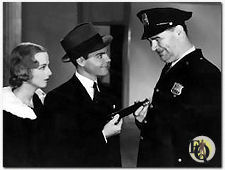 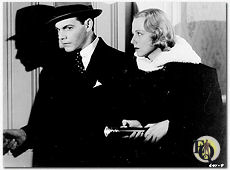 Above left: Charlotte Henry and Eddie Quillan have to do some explaining in The Mandarin Mystery (Republic, Dec 7. 1936). Above right: Charlotte Henry and Eddie Quillan |
|
He remained a favorite in large and small roles throughout the 1930s and 1940s;
he faltered only when he was miscast as master sleuth Ellery Queen in
The Mandarin Mystery
(Republic, Dec 7. 1936). Eddie was
panned by critics who felt casting him was a fatal mistake. Although the film
contained the original structure of the book,
The Chinese Orange Mystery,
the general consensus of film reviewers was that the script played for laughs,
and childish acting by Quillan and ineffective direction by Ralph Staub bought
the first series of Ellery Queen films to a halt. A heavily
edited version for television was subsequently developed but experienced no more
success than the film. Among Quillan's other more memorable credits as a supporting actor were: with Spencer Tracy in Big City (MGM, Sep 3. 1937); with Carole Lombard and Jimmy Stewart in Made For Each Other (United Artists, Feb 10. 1939); with John Wayne in Allegheny Uprising (RKO-Radio Pictures, Nov 3.1939); with Henry Fonda both in Young Mr. Lincoln (20th Century-Fox, May 30. 1939) and in The Grapes of Wrath (20th Century-Fox, Jan 24. 1940): with Marlene Dietrich in The Flame of New Orleans (Universal, Apr 24. 1941); and with Abbott and Costello in It Ain't Hay (Universal, Mar 10. 1943). |
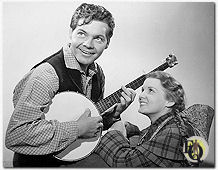 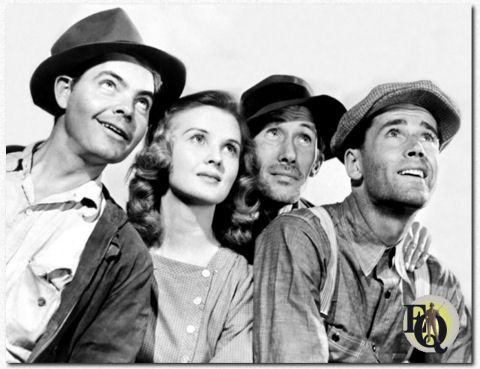 Above left: Eddie Quillan in Young Mr. Lincoln (20th Century-Fox, May 30. 1939). Above right: Promotional photo for Grapes of Wrath (20th Century-Fox, Jan 24. 1940) (L to R) Eddie Quillan, Dorris Bowden, John Carridine and Henry Fonda. |
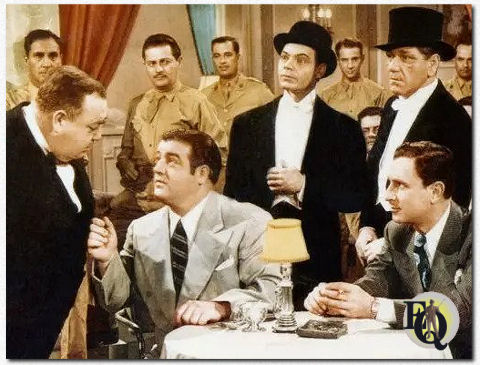 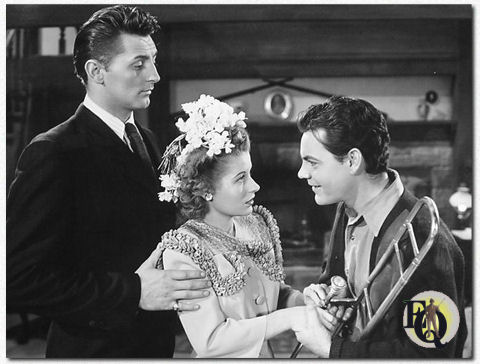 Above left: Eddie (middle) with Abbott and Costello in It Ain't Hay (Universal, Mar 10. 1943). Above right: Robert Mitchum (left) and Anne Rooney with Eddie (right) in Follow The Band (Universal, Apr 29. 1943). |
|
Discouraged with playing simple roles such as bellhops, soda jerks, et al., he
continued on in "B" pictures until Sensation Hunters
(Monogram, Oct 13. 1945) and A Guy Could Change
(Republic, Jan 27. 1946)
when his film career finally fell away. From 1948 through 1956, Quillan was paired with screen veteran Wally Vernon by Columbia as yet another attempt to create an original comedy team. Wally Vernon was a veteran of the Columbia shorts department and together they appeared in a series of 16 two-reel comedies, which showed to excellent advantage the physical dexterity of both men (below left). Since the 40s he owned and operated a bowling alley in El Monte for a time but eventually returned to the film industry, with middling results and infrequent appearances, among them Brigadoon (MGM, Sep 8. 1954) opposite Gene Kelly. |
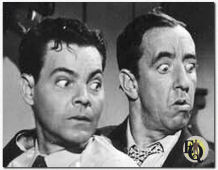 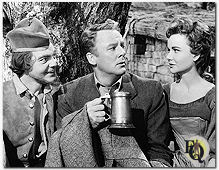 Above left: From 1948 through 1956, Quillan was paired with screen veteran Wally Vernon. Seen here in the short A-Hunting They Did Go (Columbia, Jan 15. 1948 en 1953). The plot revolves around the men embarking on a hunting weekend, closely trailed by their wives. Notably, this film is a remake, incorporating stock footage from their own movie "Crabbin' in the Cabin" (Columbia, May 13. 1948). Above right: Eddie Quillan introduces Van Johnson to Dodie Heath in Brigadoon (MGM, Sep 8. 1954). |
| In addition to his film work in the fifties, Eddie began to work in television when he was offered the chance to work with Jackie Cooper in The People’s Choice (NBC). Once beginning his television career, Eddie would appear in over two hundred (200) television programs. He had roles in a multitude of TV series: The Lucy Show (CBS, Oct 29. 1962 & Oct 18. 1965, min 2x), The Jack Benny Show (CBS, Mar 19. 1961 & Jan 1 . 1963, min 2x), Perry Mason (CBS, Apr 8. 1961 - Apr 24. 1966, min 3x), Daniel Boone (NBC, Mar 24. 1966 - Mar 26. 1970, min 4x), The Man from U.N.C.L.E. (NBC, Jan 20. 1967), The Addams Family (ABC, Oct 9. 1961 - Mar 25. 1966, min. 5x), The Wild, Wild West (CBS, Nov 17. 1967 - Feb 7. 1969, min. 2x), The Andy Griffith Show (CBS, Nov 1. 1965), and Petticoat Junction (CBS, Sep 24. 1963 - Jun 9. 1964, min. 2x).” (5) |
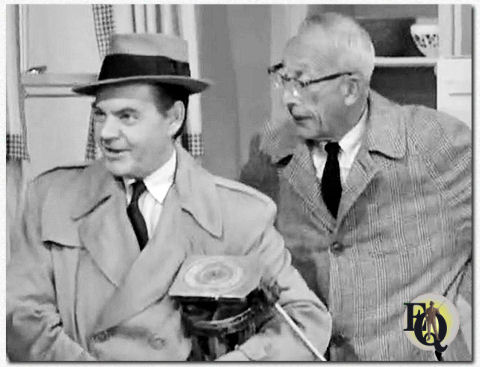 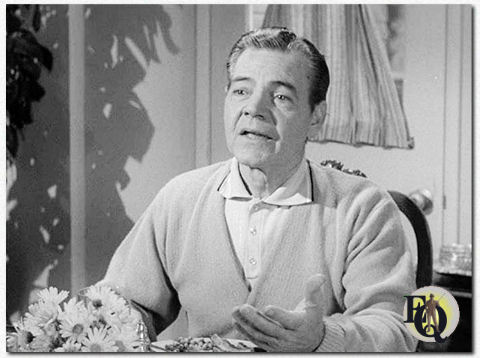 Above left: He appeared a first time with Lucille Ball on an episode of The Lucy Show (CBS, Oct 29. 1962) titled "Lucy Buys Sheep". He shared a scene with veteran actor Charles Lane. Above right: Between 1964 and 1966 he appeared 5 times in The Addams Family. He is shown here in the episode "Morticia The Decorator" (ABC, Feb 18. 1966). |
|
His brother, Joe, was a well-known comedy writer in radio and television, Known
for his contributions to the Our Miss Brooks radio and TV show. It was
through Joe that Eddie met Hal Kanter who would cast him years later in his
first recurring role in a network series, Valentine’s Day
(ABC, Sep 18. 1964 - Apr 9. 1965, min. 24x), starring Tony
Franciosa. From 1968 through 1971, Kanter made Eddie a series regular on
the Diahann Carroll sitcom Julia.
(5) Light-hearted fluff also came his way in the next decade with The Ghost and Mr. Chicken (Universal, Jan 20. 1966), Angel in My Pocket (Universal, Apr 2. 1969) and How to Frame a Figg (Universal, Feb 1971), but his contributions to these movies were relatively minor. |
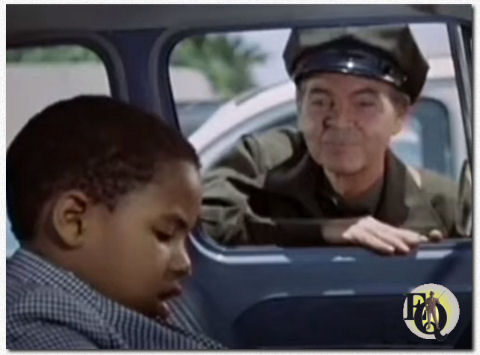 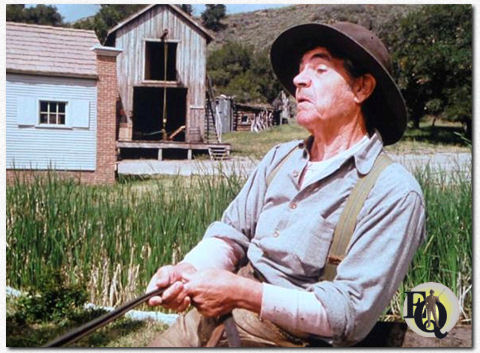 Above left: From 1968 to 1971, Quillan had a recurring role on TV's groundbreaking (the first weekly series to star an African-American woman in a non-stereotypical role) series Julia (NBC, Sep 24. 1968 - Mar 2. 1971, min 24x). He played Eddie Edson for 24 of their 86 episode run. Above right: A close friendship with actor Michael Landon led to work for Eddie in several of Landon's TV vehicles, including Little House on the Prairie (NBC, Oct 31. 1977 - Mar 7. 1983, min 7x). Eddie is seen here in the episode "To Run and Hide" aired on October 31, 1977. |
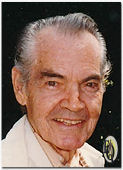 His career experienced a minor resurgence during the 1960s and 1970s on
TV when he guested on such series as Mannix
(CBS, Feb 25. 1973 - Apr 6. 1975, min. 3x), Lucas Tanner
(NBC, Jan 15. - Apr 9. 1975, min. 3x as Mr. Krebs),
Police Story
(NBC, Dec 4. 1973 - Mar 24. 1977, min . 3x), and Baretta
(ABC, Jan 11. 1978). His career experienced a minor resurgence during the 1960s and 1970s on
TV when he guested on such series as Mannix
(CBS, Feb 25. 1973 - Apr 6. 1975, min. 3x), Lucas Tanner
(NBC, Jan 15. - Apr 9. 1975, min. 3x as Mr. Krebs),
Police Story
(NBC, Dec 4. 1973 - Mar 24. 1977, min . 3x), and Baretta
(ABC, Jan 11. 1978).During this decade he was seen rarely in the movies. His last movies were Walt Disney's The Strongest Man in the World (Buena Vista, Feb 6. 1975) and Mr. Too Little (Cinema Epoch, Dec 14. 1979). A close friendship with actor Michael Landon led to work for Eddie in several of Landon's TV vehicles, including Little House on the Prairie (NBC, Oct 31. 1977 - Mar 7. 1983, min 7x), Father Murphy (NBC, Dec 7. 1982) and Highway to Heaven (NBC, Sep 19. 1984 - Dec 17. 1986, min. 3x). |
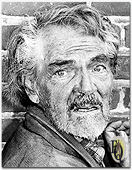 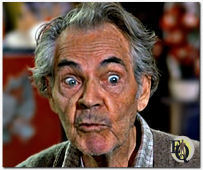 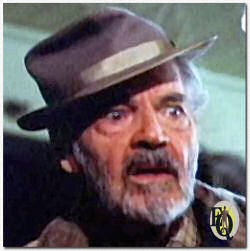 Above left: Eddie as he appeared in the 1985 series Hell Town (Mar 6. - Dec 25. 1985, min. 9x as Poco Loco). Above middle: Quillan as Abbie Cadabra in the Moonlighting episode "In God We Strongly Suspect" (ABC,Feb 11. 1986). Above right: Eddie's last screen appearance came in "The Author" an episode of Matlock (NBC, Aug 6. 1987). |
|
In his retirement years, Eddie continued to lead an active life enjoying golf,
bowling and swimming. A lifelong bachelor, he lived in North Hollywood (San
Fernando Valley) with his
two sisters, Peggy and Roseanne.
Eddie Quillan became a favorite interview subject for film historians thanks to his ingratiating personality and uncanny total recall. Eddie died in Burbank, California of cancer in 1990 at age 83, on July 19. 1990 and was interred at the San Fernando Mission Cemetery in Mission Hills. Eddie prided himself in being a comedian and as he once told one producer, who was trying to insert an off-color joke, he obviously didn't need him because he could get anyone to get a laugh with a dirty joke, no talent is needed. |
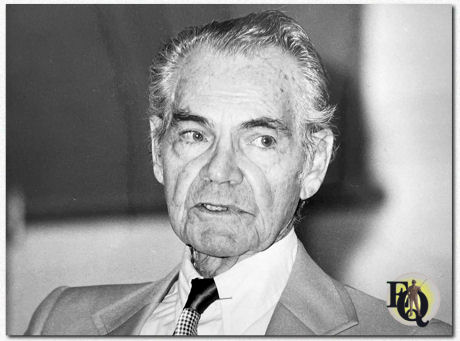 |
|
Notes: All dates for movies are for the first US release. All dates for TV programs are original first airdates. All dates for (radio) plays are for the time span the actor was involved. Facts in red still need confirmation. |
|
Click on Uncle Sam if you think you can help out...!
|
|
Other references (1) Wikipedia (2) IMDb (3) The Columbia Shorts Departement (4) Mack Sennett's Fun Factory: A History and Filmography of His Studio and His Keystone and Mack Sennett Comedies, with Biographies of Players and Personnel by Brent E. Walker (2013) (5) Playbills to Photoplays: Stage Performers Who Pioneered the Talkies by Brenda Loew (2010) (5) Radiogoldindex (6) Rotten Tomatoes (7) The Eddie Quillan Film Festival: "Sweepstakes" and "Gridiron Flash" at "The Incredible Inman" (8) Day and Quillan, "The Flaming Youth" Comedies by Lea Stans (Comique - The Classic Comedy Magazine, Issue no. 2, Spring 2022) (9) The Godless Girl a Silent Movie Review Additional video & audio sources (1) Sweepstakes 1 - 2 -3 (Clips, 1931) YouTube, David Inman (2) Gridiron Flash 1 - 2 - 3 (Clips, 1934) YouTube, David Inman (3) Nobody's Home 1 - 2 (Short, Two reel, 1955) YouTube, David Inman (4) The Sophomore Jeanette Loff Eddie Quillan (Clip from the 1929 Silent) YouTube Annie Carol (5) Night work (full movie, 1930) YouTube, Lost n Found Films (6) Club Paradise (aka Sensation Hunters,full movie, 1945) YouTube, Hollywood Classics. |
|
This actor profile is a part of
Ellery Queen a website on deduction.
The actor above played Ellery Queen in
an Ellery Queen movie.
Click Uncle Sam if you think you can help
out...! Many of the profiles on this site have been compiled after very careful research of various sources. Please quote and cite ethically! |
|
Page first published on May 27. 2017 Version x2.1 - Last updated April 22. 2025 |
 b a c k
t o L i s t o f S u s p
e c t s
b a c k
t o L i s t o f S u s p
e c t s
|
|
| Introduction | Floor Plan | Q.B.I. |
List of Suspects | Whodunit? | Q.E.D. | Kill as directed | New | Copyright Copyright © MCMXCIX-MMXXV Ellery Queen, a website on deduction. All rights reserved. |